Play Part 1 – Part 2 – Part 3 – Part 4
Part 1 - Introduction - Retail disruption
Simon Goddard - Industry Marketing Manager, MuleSoft
Part 2 - The omnichannel business case
Kiku Mlosch - Global E-Commerce Project Manager, GANT
Part 3 - The API solution
Gustav Rosén - Integration Architect, Entiros
Part 4 - Q&A
Albin Kjellin - Retail API specialist, MuleSoft
Retail disruption - How GANT tackled omnichannel
Retail stands as one of the most digitally disrupted industries to date with over 60% of purchases now said to be influenced by digital interactions, according to Deloitte. Against this backdrop, global retailer GANT is trailblazing a strategy which enables digital transformation to be the catalyst for the GANT ecosystem.
Hear direct from Kiku Mlosch, Global E-Commerce Project Manager at GANT, and supporting partner Gustav Rosén, Integration Architect at Entiros, as they reveal their journey and approach to making omn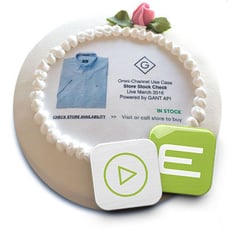 ichannel “a piece of cake”.
ichannel “a piece of cake”.
You will learn:
- How GANT approached omnichannel and is targeting the retail digitalization opportunity
- Real-life lessons from an IT strategy that is taking a business from stabilization to innovation to excellence
- Practical steps to creating a center for enablement in technology and embracing a new IT operating model that empowers the wider organization
Part 1 - Introduction - Retail disruption
Simon Goddard, Industry Marketing Manager, MuleSoft
Introduction and background content to the webinar.
- How GANT approached omnichannel and is capitalizing on consumer demand for digital product
- Real-life lessons from an IT strategy that is taking a business from stabilization to innovation to excellence
- Practical steps to creating a center for enablement in technology and embracing a new IT operating model that empowers the wider organization
There is a digital transformation in retail. Retail being the most digitally disrupted industry with over 60% of the US retail will account for or being influenced by online or e-commerce. The competition is clearly increasing; IT has to deliver to the increasing demands.
What is the definition of digital transformation?
- Achive operational and supply chain excellence to compete
- Deliver a consistent experience across in-store, web and mobile
- Expand and grow in new geographies and distribution channels
This increases the demand on IT. Can IT go fast enough? Is the capacity increasing with the increase of demand? The gap gets wider!
What steps can you take to get IT to next level and shift the way IT is operating. IT need to get into a new role, from reactive to a center of enablement. Which is enabling the business to self-service and deliver more of their own projects the right way. With reusable APIs and services for accessing data and resources.
The GANT project is a perfect example of how this can be made.
Part 2 - The omnichannel business case
Kiku Mlosch, Global E-commerce project manager, GANT
GANT are using three sales channels:
- direct to consumer, via GANT flagship stores
- wholesales, sales to retailers, both online and offline
- e-commerce via GANT.com, the fastest growing channel
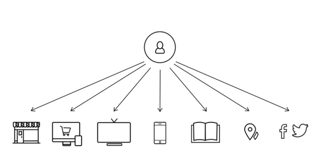
GANT need to meet the customer in all channels, and make the omnichannel customer happy. They might see a product in social media, talk to a friend about it, check the website about the clothes and finally shop at a store. This omnichannel customer is a demanding customer with a lot of expectations. Our mission is to provide a seamless experience across all channels.
GANT have launched a few services before this, for example gift cards that you can redeem and buy online and offline. Click and collect, buy online and collect at store.
The project in focus in this webinar is called Online Store Stock Check. Which means, customers should be able to check offline store stock online, and visit to buy or call to order.
This type of function might look easy in the front end but is quite complex back end. Three systems need to be integrated; the e-commerce platform, the PIM system, with store information, address etc. and finally the retail system containing all stock data.
To move fast in a changing world and get this type of features implemented fast and not in months GANT turned to an integration specialist, Entiros. Gustav Rosén founder and Integration Architect will explain how GANT tackled omnichannel.
Part 3 - The API solution
Gustav Rosén, Integration Architect, Entiros
This feature, Online Store Stock Check, actually only took GANT three weeks to implement. Was it a piece of cake? No it was not a piece of cake, it was actually two cakes!
Entiros has worked as an integration partner with GANT since 2011, in order to enable fast delivery on omnichannel features. We do this by providing a foundation, using a GANT API, the digital highway to GANT.
We are running the GANT Integration Center enabling digital transformation as a catalyst for the GANT eco-system. And also powering this with GANT Integration Bus, a universal connectivity bus that connects to back end systems. It’s a combination of API and connectivity.
So let’s dig down deep. The GANT story can be divided in two modes.

MODE 1
Think Marathon Runner
Goal – Reliability
Value – Price for performance
Approach – Waterfall, V-Model, high-ceremony IID
Governance – Plan-driven, approval-based
Sourcing – Enterprise suppliers, long-term deals
Talent – Good at conventional process, projects
Culture – IT-centric, removed from customer
Cycle times – Long (months)

MODE 2
Think Sprinter
Goal – Agility
Value – Revenue, brand, customer experience
Approach – Agile, Kanban, low-ceremony IID
Governance – Empirical, continuous, process-based
Sourcing – Small, new vendors, short-term deals
Talent – Good at new and uncertain projects
Culture – Business-centric, close to customer
Cycle times – Short (days, weeks)
But in order for GANT to fly we needed to start from the ground, by crawling, walking, running and finally fly away with innovations.
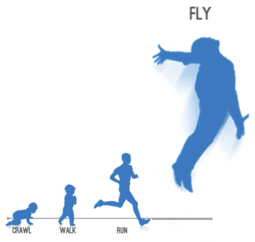
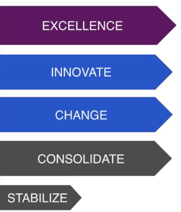
Step 1 - Stabilize and consolidate
- Stabilize key information flows with unified monitoring
- Set silver, gold, platinum SLAs
- Apply blueprint for connectivity and mediations cross services
- Reuse services between markets
- Mediate the necessary market specifics
Step 2 – Change and innovate
When you have connectivity, structure and documentation it’s time for step 2.
How are we going to provide the information?
We put up a service based architecture with an integration layer on top of the services. When GANT wants a feature, like Online Store Stock Check, we could plug it in to the integration bus with the created GANT API. Fast and effective.
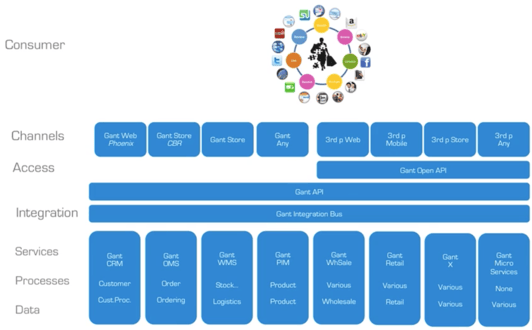
Step 3 – Excellence
In this stage we’re not only focusing on the integration architecture and technology ownership. Now the import part is enablement, letting the different stakeholders on GANT onboard the API and let them start innovate. The API platform is providing a foundation and allow them to reuse the assets and enable new fantastic features.
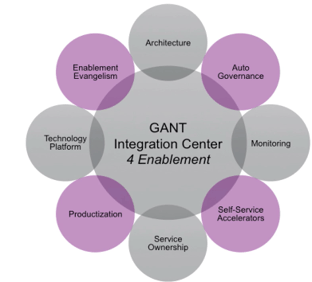
Part 4 - Q&A
Kiku Mlosch, Global E-commerce project manager, GANT
Gustav Rosén, Integration Architect, Entiros
Albin Kjellin - Retail API specialist, MuleSoft
What is the one top tip from the whole experience?
Kiku: From a business perspective I would say, involve all different parties in the project, offline and online. Get everyone on the train.
Gustav: Taking on the technology perspective. In this type of omnichannel initiatives, try to avoid taking the silo and point to point solution path. Remember the sprinter and the marathon runner, build a foundation to harvest from. Enable fast implementations and reuse to get innovation.
How quickly did the initiative pay for itself?
Kiku: The first country we implemented it in did of course take a larger bit of the cost, taking about 2-3 months to see a return of investment. The role out to the other markets was then very fast and to half or a third of the cost.
What was the biggest investment area so far in the project?
Gustav: Building the foundation of the GANT API, an investment for further innovation, the possibility of reuse and fast integration between systems.
Kiku: Yes, that’s probably deciding to build the GANT API.
How do you manage performance, because the search area around the zip codes can lead to lots of stores?
Kiku: At the moment it is not an issue, because of the number of stores isn’t that big.
Is MuleSoft only available in the cloud?
Albin: No it is available as on perimeter deployment as well as in the cloud.
How much time did the project take, from start to the first implementation?
Gustav: This was one of those rapid projects, a mode 2 delivery. The way that we managed the milestones was to use a clear methodology, called Flow on Entiros. That is focusing much on the stakeholders, that everybody got a good start up and knew their role in the project. The core of the project was three weeks and the milestones was met.
How many resources and key competences was required from GANT?
Kiku: Project manager, graphic designer, front-end developer, IT and the retail manager in the UK was a part of the project from GANT.
Gustav: We are working as a team, with different people and roles depending on the specific project or parts of the project. We approach these kind of integrations with a good FlowLead; an Integration Project Manager and take onboard the special competence needed, as integration architects, integration specialists and maybe someone with good operational knowledge. A team effort with small engagements of the person best suited at the moment.
Are GANT going to use Chat Bots in the future?
Kiku: In customer service Chat Bots can be very interesting for us to use in the future.
What are the current challenges for the current API-landscape?
Gustav: The major challenges now are not in the technology; it’s getting these API used in the GANT group. Marketing the APIs providing self-service accelerators. There are always integrations needed to be done, but I would say the biggest opportunity is to market the integration centre of enablement to power omnichannel features.
Other questions handled within the webinar:
How did you do with the legacy system integration/migration?
How do you deal with the regulatory challenges when it comes to integration?
How successful have the GANT integration spaghetti landscape been reduced?

